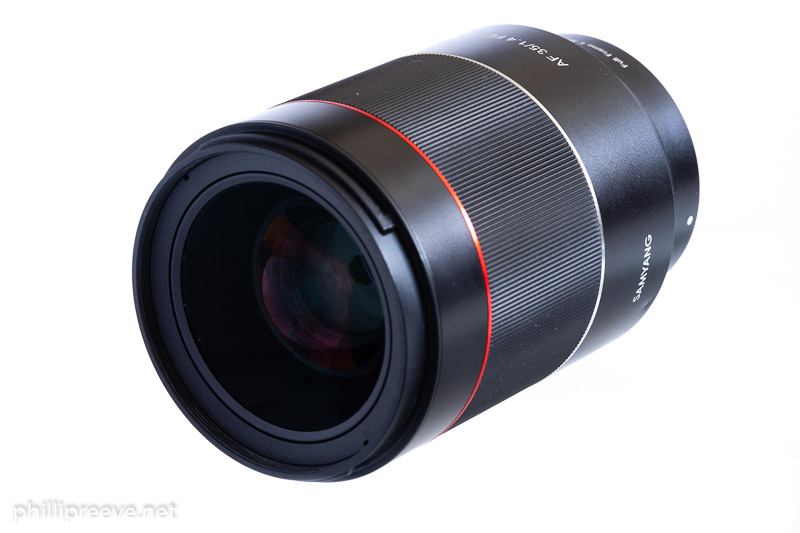
The Samyang AF 35/1.4 FE is the most affordable in the croweded field of fast 35mm AF E-mount lenses. I this review I try to answer the question if it is a smart buy.
Samyang AF 35/1.4 FE Review
Most images in this review can be found in full resolution in my Samyang AF 35/1.4 FE flickr set. There you can also browse samples in a very high quality browser.
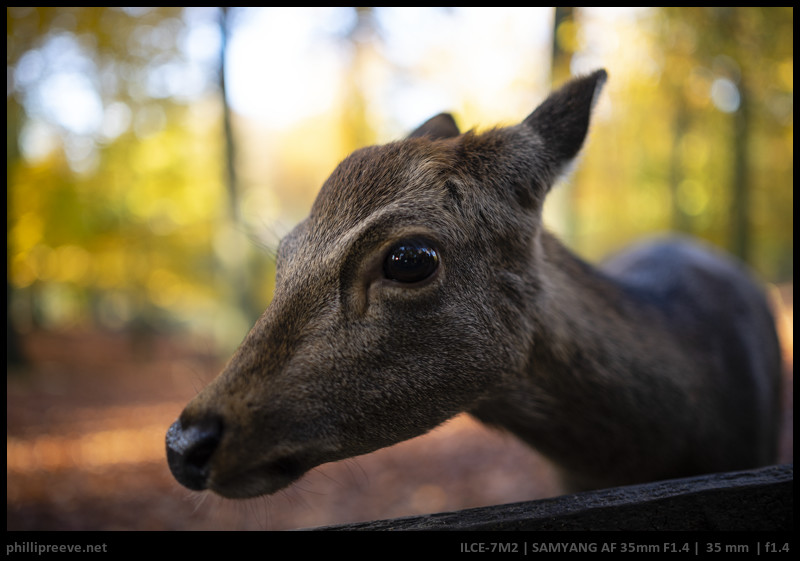
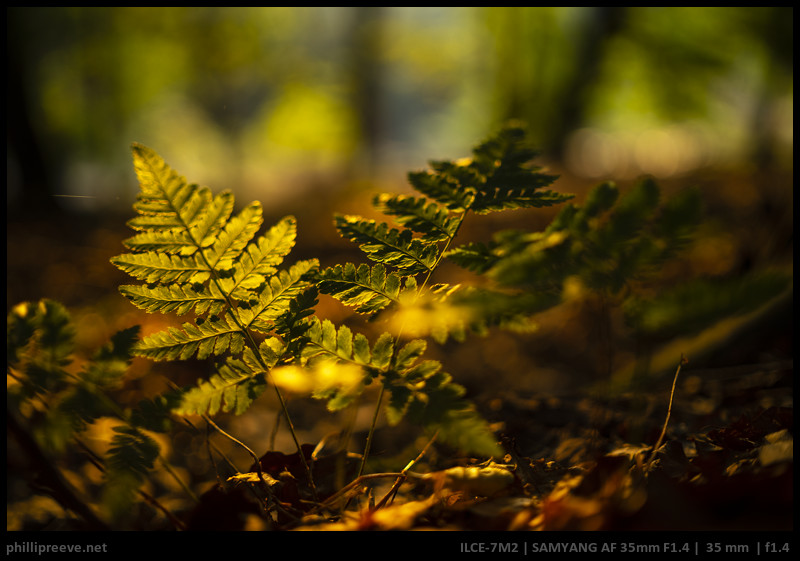
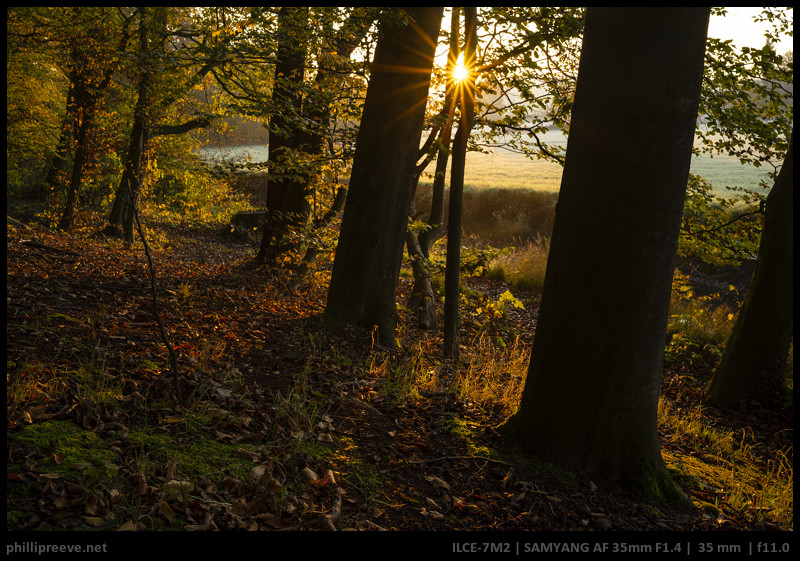
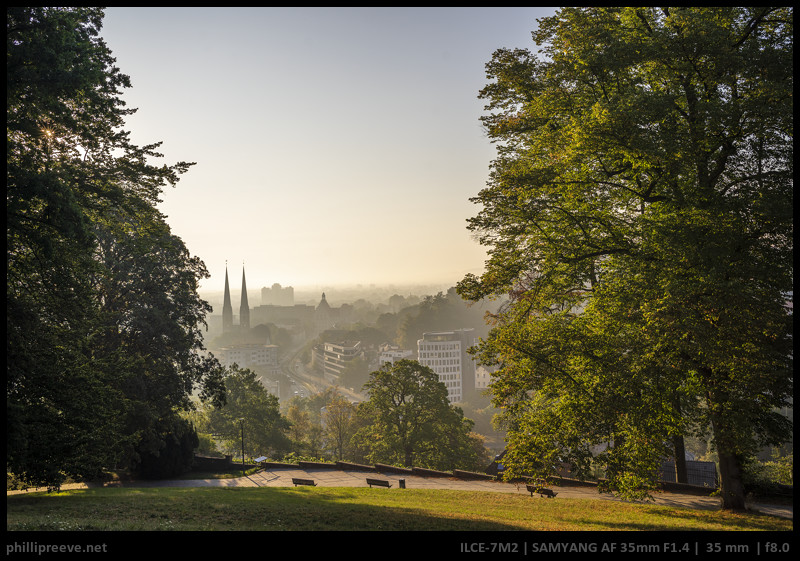
Specifications
| Diameter | 76 mm |
| Length | 115 mm |
| Filter Thread | 67 mm |
| Weight (no hood, no caps) | 645 g |
| Max. Magnification | 0.17 |
| Close Focusing Distance from the sensor | 30 cm |
| Number of aperture blades | 9 |
| Elements/ Groups | 11/9 |
| Mount | E-mount |
The Samyang 1.4/35 has a recommended price of $799 but usually sells for significantly less. Check current prices at amazon.com, B&H or ebay.com. In Germany the recommended price is 649 €. Check at amazon.de.
If you purchase the lens through one of these affiliate-links I get a small compensation with no additional cost to you.
Disclosure
I bought this copy used from my own money and used it for several months before writing this review.
Features
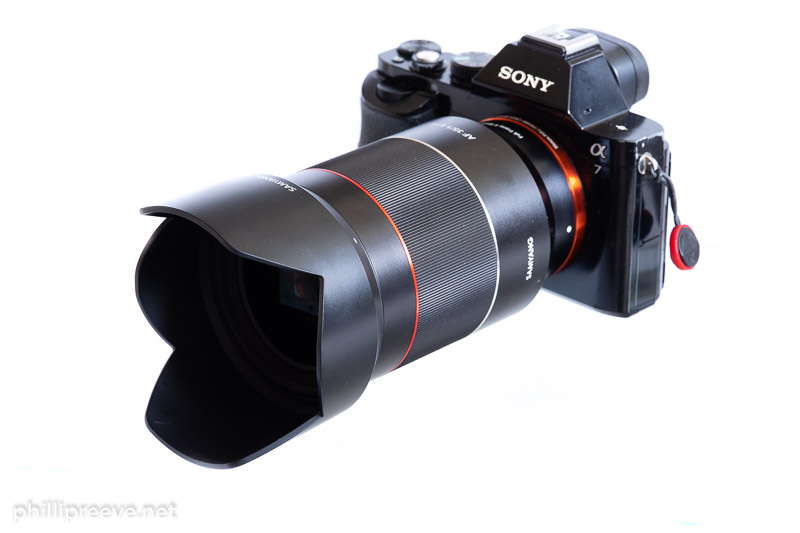
The Samyang AF 35/1.4 FE offers no buttons or any other features worth mentioning.
Samyang offers a lens station ($60) to update firmware and change some settings. I am not sure I should call this a feature though since other manufacturers offer firmware updates without a dock and Samyangs firmware 01 and 02 had serious issues so I would strongly recommend to update it if you have an older version installed.
Build quality
The Samyang AF 35/1.4 FE feels nice enough thanks to a metal hull and a wide focus ring with a little low resistance. It doesn’t feel or look as a $1000 lens but at the same time it doesn’t feel cheap either.
Samyang does not claim any weather resistance and the 1.4/35 does not have a rubber gasket.
As a team we have had several bad experiences with Samyang lenses which broke with no obvious reason. An experience many other users have had as well, going by forum entries and Amazon reviews. Also we have experienced above average variation with Samyang lenses as documented by lensrentals.com. Of course lenses from other manufacturers break as well but it seems to be a lot more likely with Samyang lenses. I am not in a situation where I could put a reliable number on this but it is an aspect which I would keep in mind when buying a Samyang lens. The risk is offset in part by generous warranties offered by Samyang in some markets.
Handling
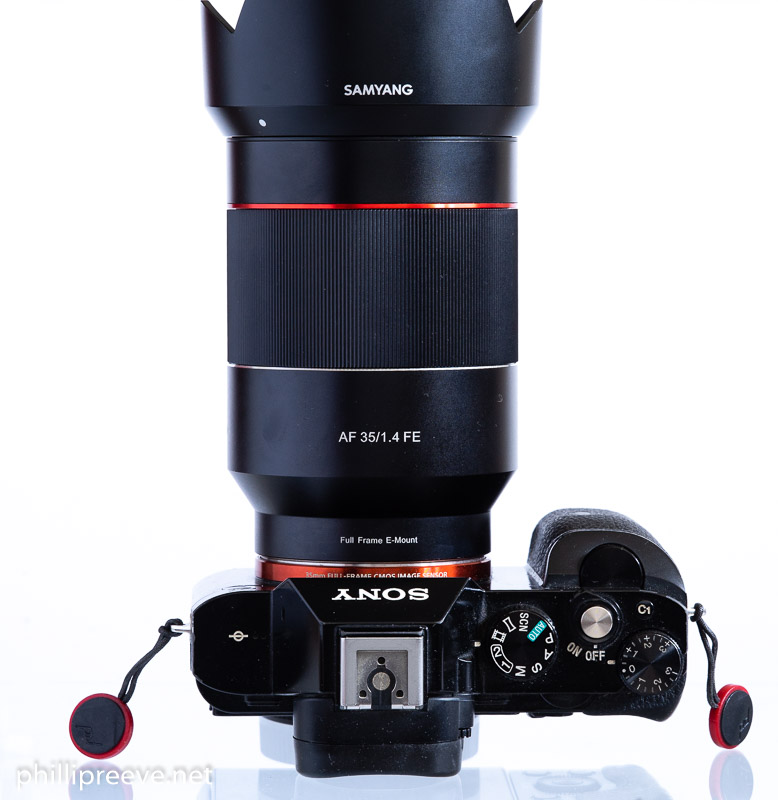
AF
I used the Samyang 35/1.4 only on my a7II wich is a much slower focusing camera than the a7III and Sony’s other new models but I never felt limited by the AF-speed of the lens. AF makes a small noise which will probably be an issues for video but it is a non-issue for photography. AF-reliability is an issue though. It works ok most of the time but in other scenarios it is simply unreliable.
Manual Focus
The focus ring offers too little resistance in my eyes. It isn’t linear but close to that. In the default setting it travels around 90° from 0.3m to infinity which is way too steep. If you have the dock you can adjust it so that it travels around 180° which makes focusing easier but still no joy. The biggest issue I have is that focus jumps from one position to the next and it often feels like there are too few intermediate positions.
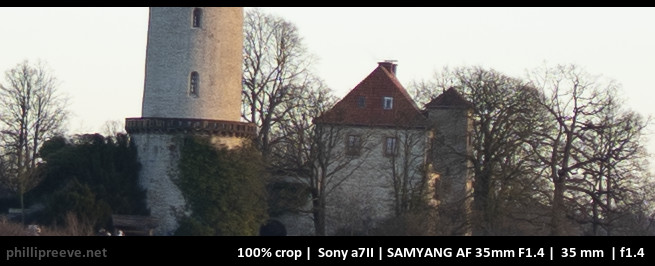
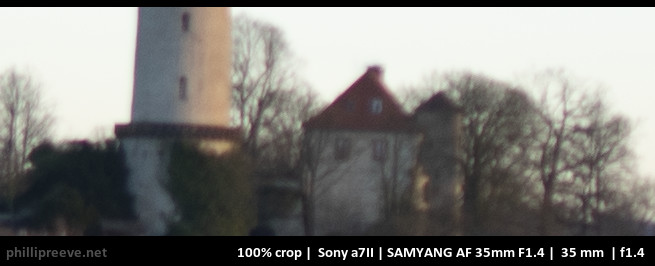
Hood
The Samyang 35/1.4’s hood is made from plastics, locks safely into place and protects the front of the lens well. It also adds a lot of bulk to the already bulky lens.
Size and Weight

At just 645g the Samyang 35/1.4 is a rather big an heavy lens. It weights 15g more than the Sony ZA 1.4/35 and 95 less than the Sigma 1.4/35. If you compare it to the Sigma Art 1.2/35 though it looks like a small and light lens being 435g lighter. The half a stop slower Sony 1.8/35 is significantly smaller and less than half the weight.
Optical performance
These results are based on the use with a Sony Alpha 7II.
Flare Resistance
As always evaluating flare is a complex matter since you can get any lens to look bad if you push it hard enough and a slight change of scenario will affect results a lot.
I would rate the Samyang 35/1.4 as below average when compared to other modern fast 35mm lenses. In a very challenging scenario results can look pretty bad with a red halo and significant ghosting as well as an above average amount of veiling flare. In a little less challenging scenarios I found performance ok.
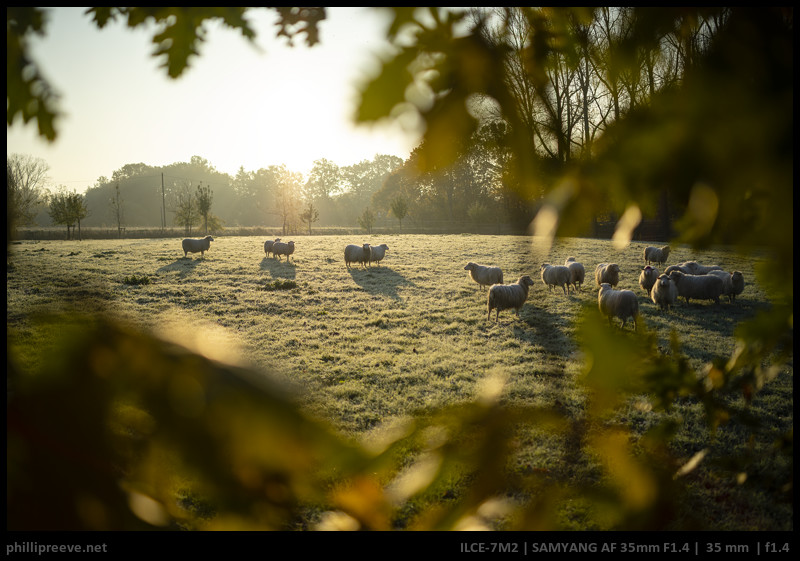
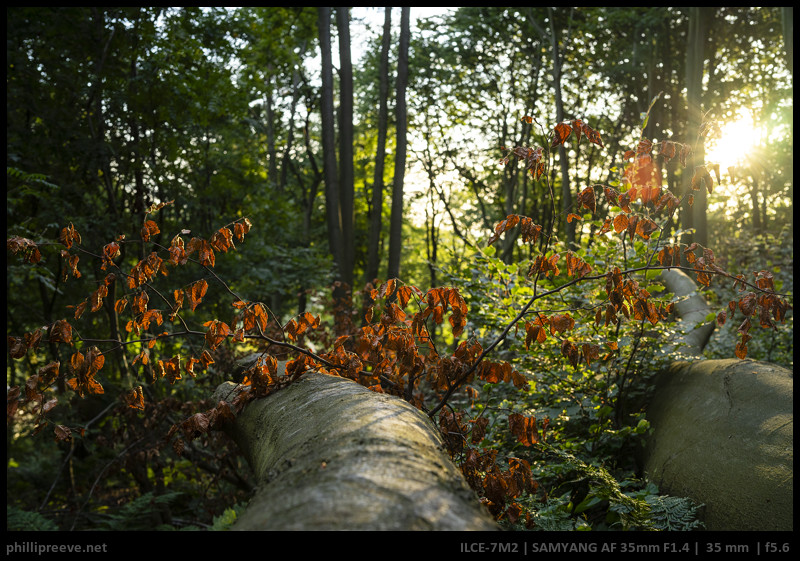
Sunstars
9 rounded aperture blades result in well defined 18-pointed sunstars from f/11.

Bokeh
- Out of-focus-highlights are rendered neutral with little outlining at shorter distances and some outlining off-center at longer distances.
- Bokeh circles show minor onion rings. They also stay more or less round as you stop down.
- Cat’s eyes are visible but they aren’t very pronounced.
- The transition zone is a bit nervous.
In most scenarios you can expect rather smooth bokeh from the Samyang 35/1.4 but in more difficult scenarios with high contrast background at longer distances bokeh can become somewhat harsh. A characteristic it shares with most other 35mm lenses.
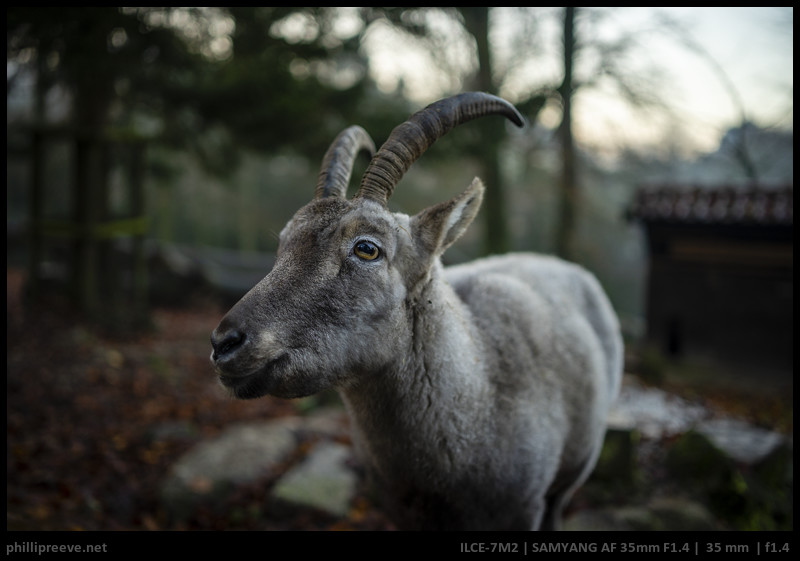

Chromatic Aberrations

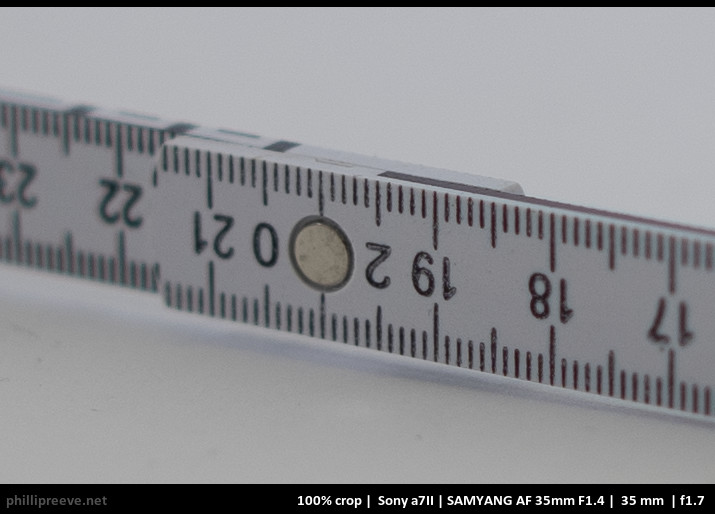
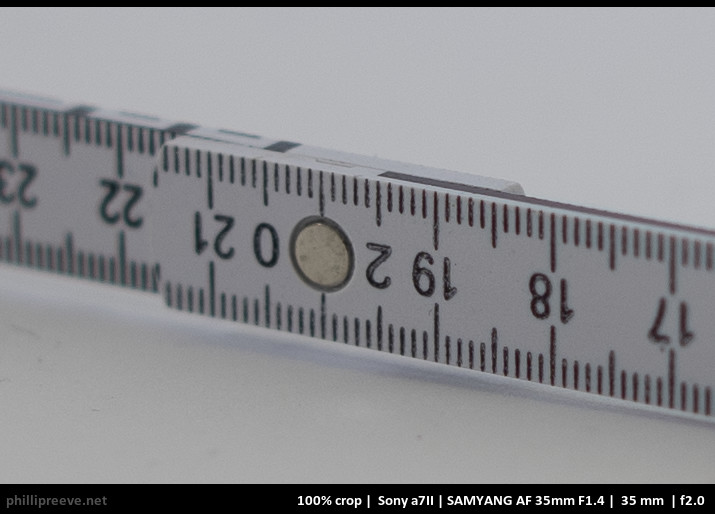


Axial CA isn’t well corrected until f/4 and in high contrast scenarios you will see quite bit of color fringing. This is usual for a fast 35mm lens and can be manually corrected to some degree.
Since I use LR correction of lateral CA is corrected by profile and I can’t turn the correction off. It isn’t corrected that well though and some CA is still visible.
Vignetting
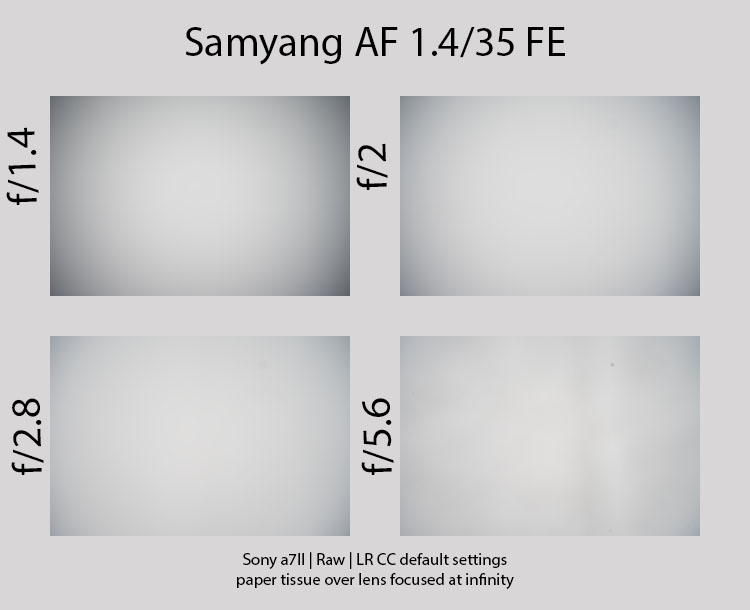
| Aperture | Vignetting |
| f/1.4 | 2.3 EV |
| f/2 | 1.7 EV |
| f/2.8 | 1.2 EV |
| f/4 | 1.0 EV |
| f/5.6 | 1.0 EV |
Vignetting is moderate for a fast 35mm lens at 2.3 stops wide open which is reduced to 1 stop at f/5.6.
Distortion
A rather high amount of mostly barrel correction. +9 in LR corrects it to a degree but not perfectly.
Astro-Performance
Even wide open the Samyang shows a very solid performance. It also shows the least vignetting of any competing E-mount 35mm.
Sharpness
infinity
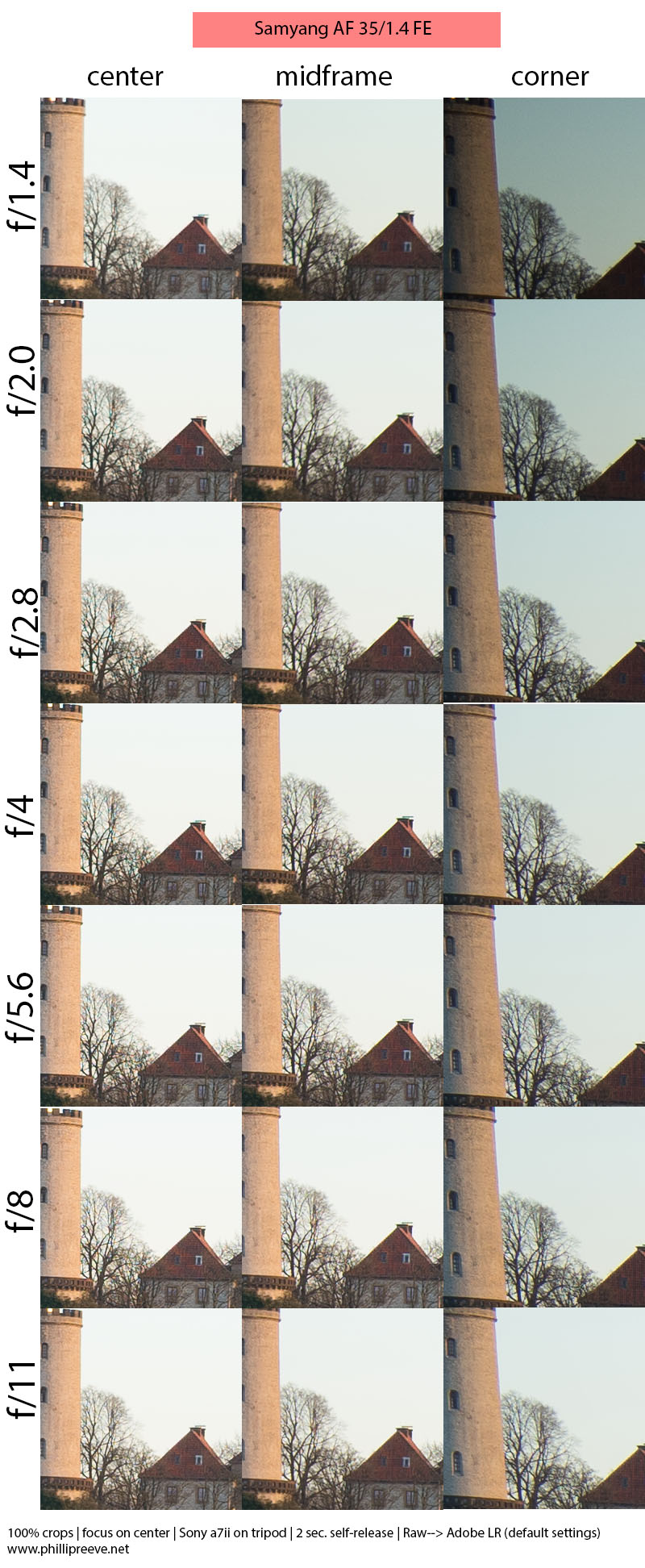
f/1.4: Good to very good in the center. Good outside of it.
f/2: A noticeable improvement over f/1.4 everywhere.
f/2.8: Excellent in the center, good to very good outside of it.
f/4: Excellent to very good across the frame.
f/5.6: An excellent performance with minor falloff towards the corners.
f/8: A tad softer everywhere.
f/11: Somewhat softer due to diffraction.
All in all a very good performance. You can use f/1.4 with little hesitation for most applications and by f/4 you can expect very good results even in the corners. Only the most demanding users will want to look for slightly better performance in the ART 1.2/35.
Because there is quite a bit of field curvature the midframe area is significantly sharper at wider apertures if you refocus at it.
Portrait Distance
You can place the eye of your subject freely anywhere in the frame and expect very good results from wide open. A very good performance.
Alternatives

Sigma Art 1.4/35: The Sigma is about $200 more expensive than the Samyang and nearly 100g heavier. If you need to save a month longer to get it over the Samyang I would. While the optical performance is very similar the more reliable AF, much better manual focus and especially better longevity will make it the more attractive alternative in my eyes.
Sony ZA 1.4/35: A $1600 lens which is decentered more often than not. Optical performance is comparable to the Samyang.
Sigma Art 1.2/35: The current king of 35mm lenses. At least in E-mount. It is quite a bit sharper and it is currently the only E-mount 35mm lens which offers smooth bokeh across the frame at any distance. It is also two to three times as expensive and 450g heavier.
Sony FE 1.8/35: It is half a stop slower with a little less smooth bokeh and higher vignetting but it is much more portable and not even half the weight and flare resistance is better. It is significantly more expensive though.
Voigtlander 1.4/35: A close relative of a 40-years-old Leica with corresponding performance. If you like character lenses.
Conclusion
pros
|
average
|
cons
|
The Samyang AF 35/1.4 FE delivers surprisingly good optical performance for its very affordable price. Sure, flare resistance is below average and it shows quite a bit of CA and distortion is also a little above average but it can compete with the significantly more expensive Sony ZA 1.4/35 and also the still more expensive Sigma 1.4/35 which aren’t perfect either.
The bigger tradeoff lies in the Samyang’s handling: Manual focus is one of the worst implementations I have used on E-mount and AF wasn’t that reliable either in my experience. I also had to buy the dock for another 50 bucks to update the firmware because with the old firmware it froze my camera several times during a wedding.
The Samyang AF 35/1.4 FE is capable of delivering results comparable to significantly more expensive lenses and in general I was quite happy with the results. No other 35mm will give you as much optical performance for a similar price. There are non-trivial trade-offs in handling and longevity though which should be taken into consideration when making a purchase decision.
The Samyang 1.4/35 has a recommended price of $799 but usually sells for significantly less. Check current prices at amazon.com, B&H or ebay.com. In Germany the recommended price is 649 €. Check at amazon.de.
If you purchase the lens through one of these affiliate-links I get a small compensation with no additional cost to you.
More Image Samples
Most images in this review can be found in full resolution in my Samyang AF 35/1.4 FE flickr set. There you can also browse samples in a very high quality browser.
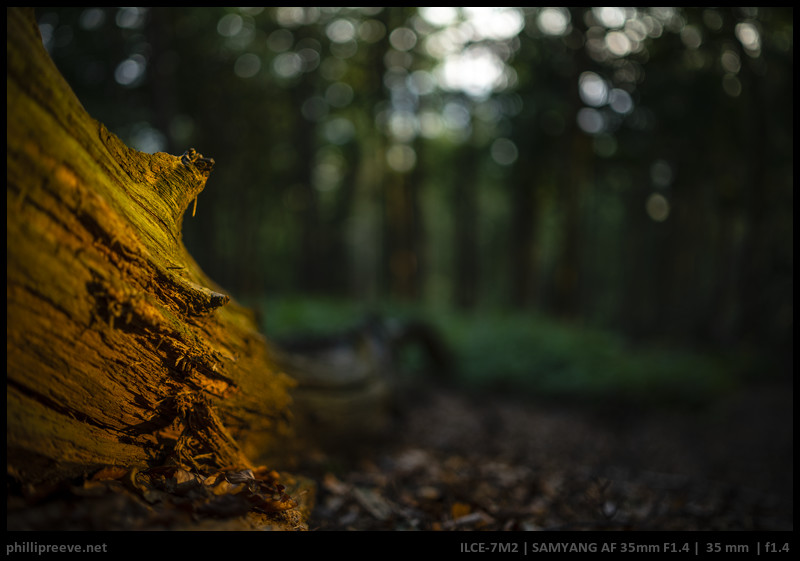


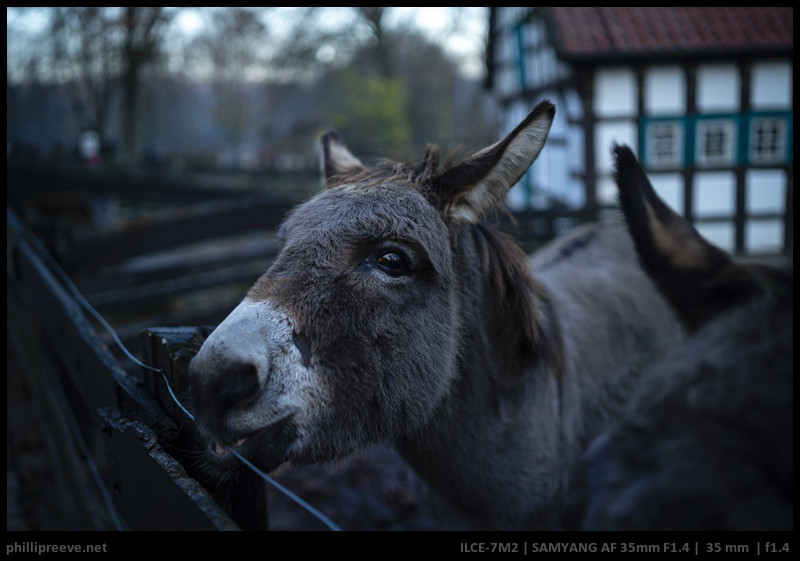
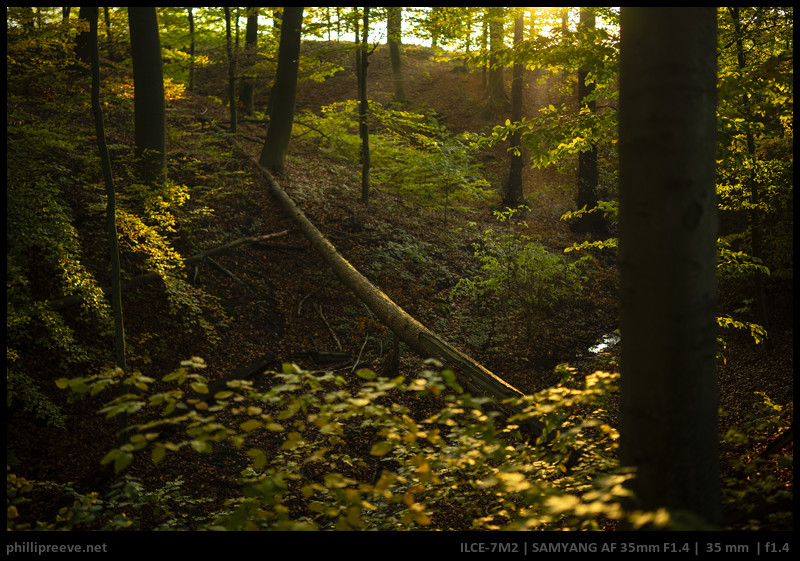
Other articles
- The best lenses below $499 for the Sony a7 series
- Sony FE List
- Guide to best Sony E-Mount 35mm Lenses
- Review: Sony FE 1.8/35
This site contains affiliate links. If you make a purchase using any of the links marked as affiliate links, I may receive a small commission at no additional cost to you. This helps support the creation of future content.
Latest posts by Phillip Reeve (see all)
- Review: Samyang AF 75/1.8 FE - April 12, 2021
- The FE-List now has 113 lenses on it - March 25, 2021
- 2020 – Year’s end review - December 28, 2020

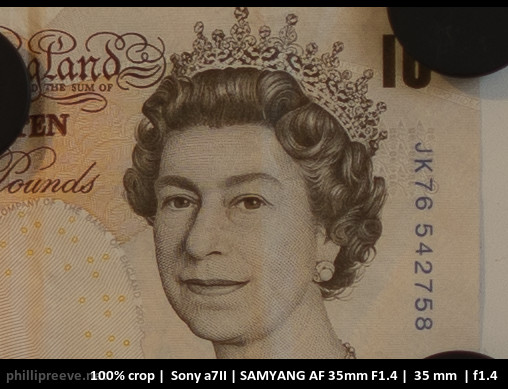
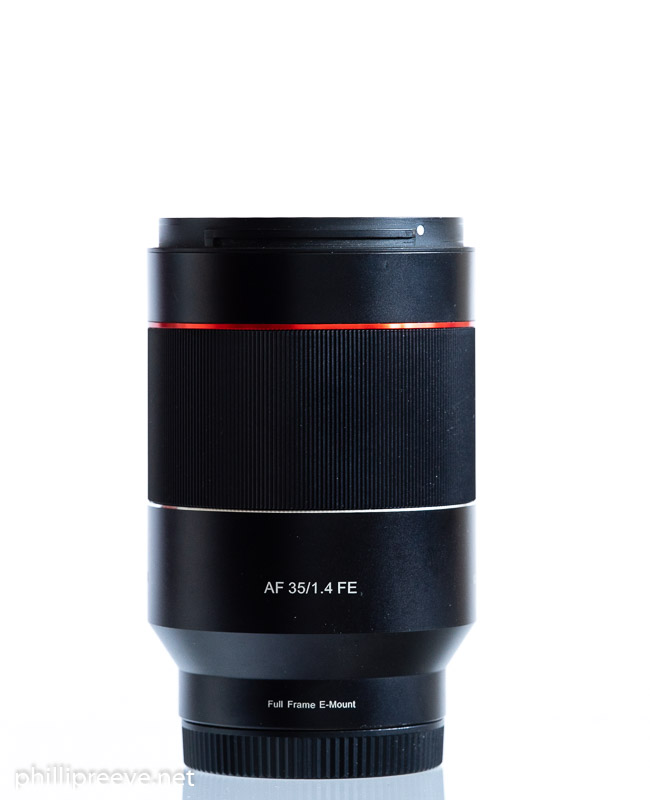
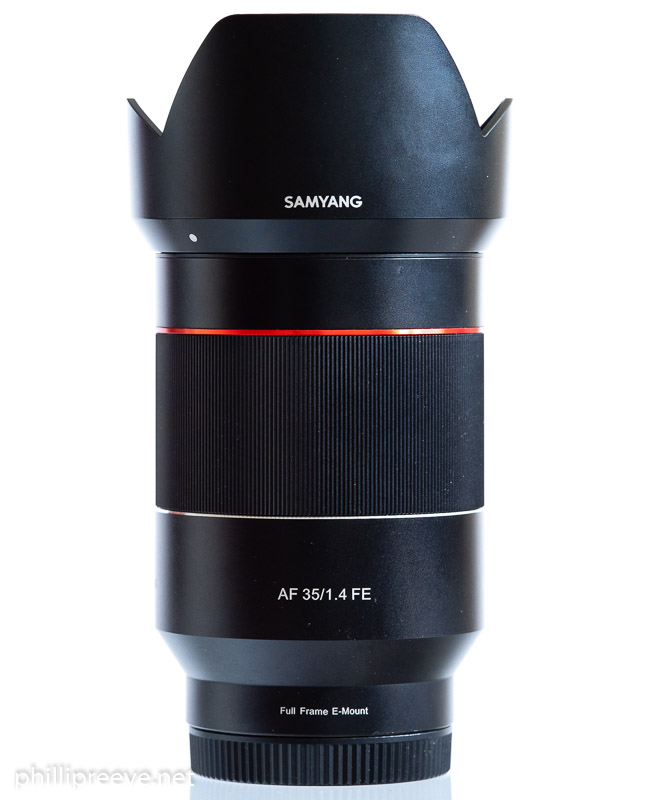
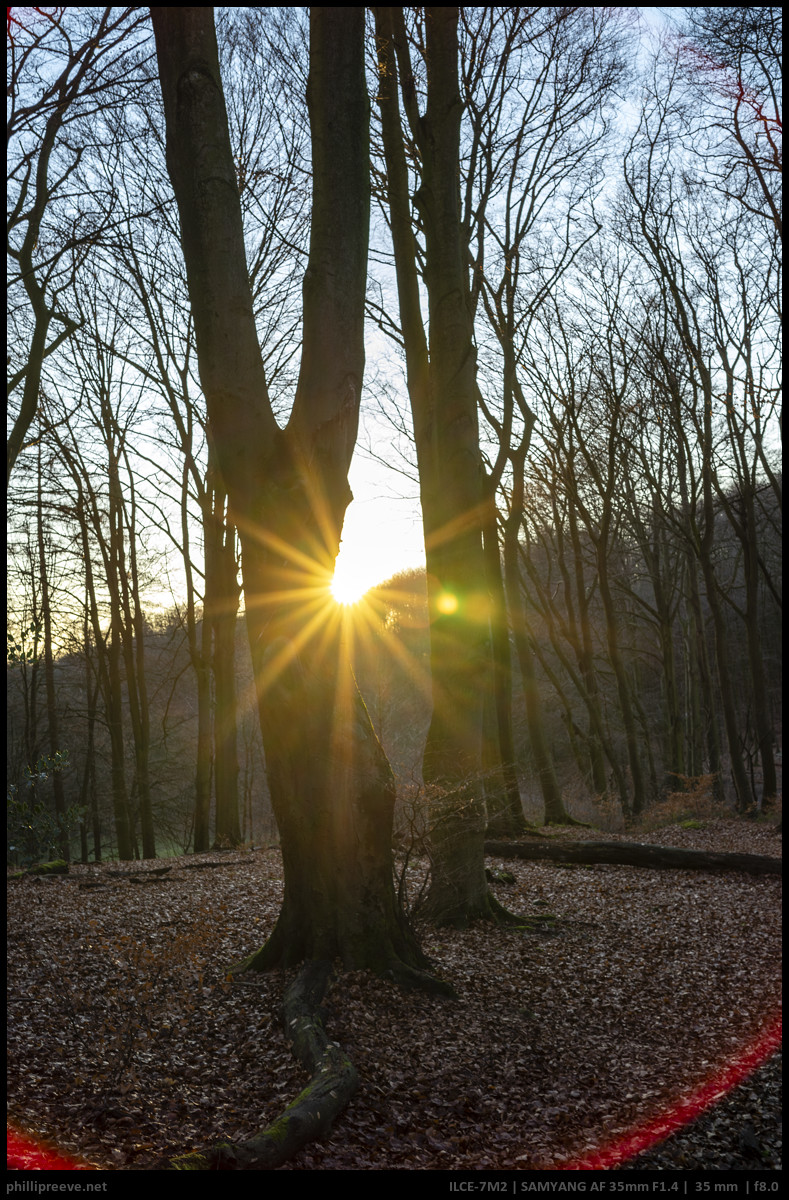


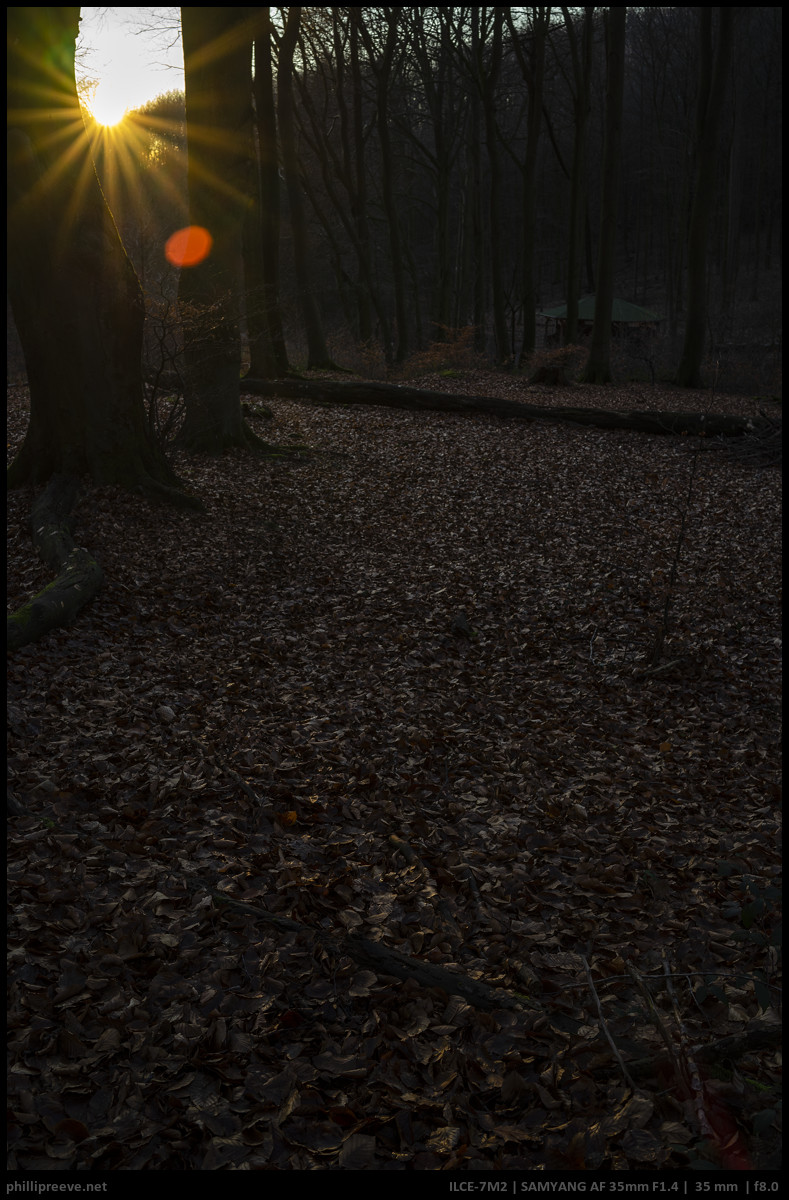
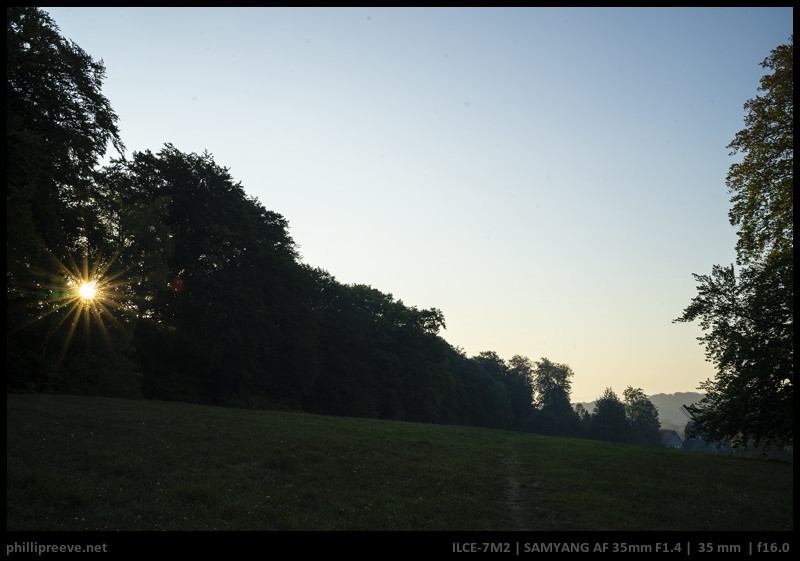
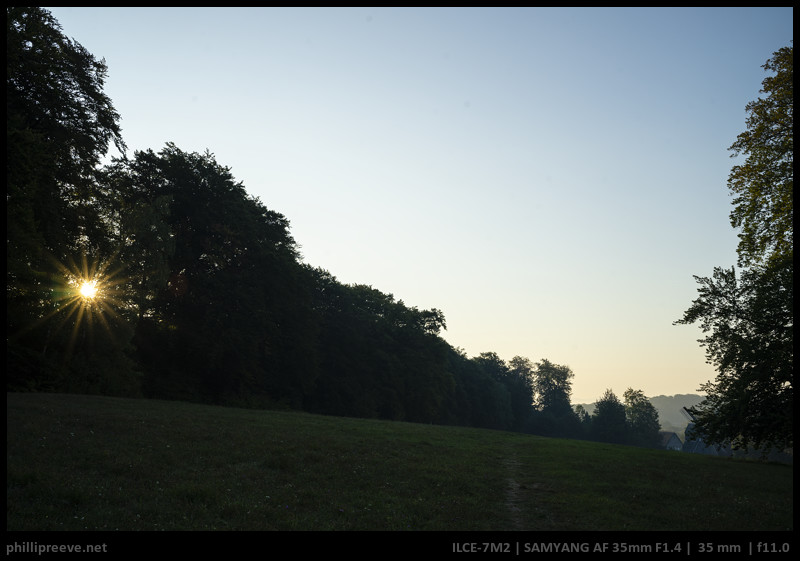
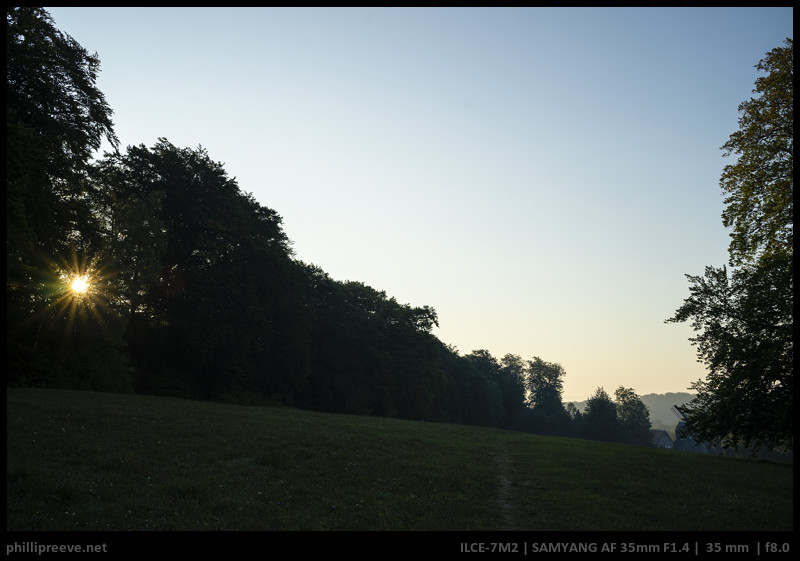
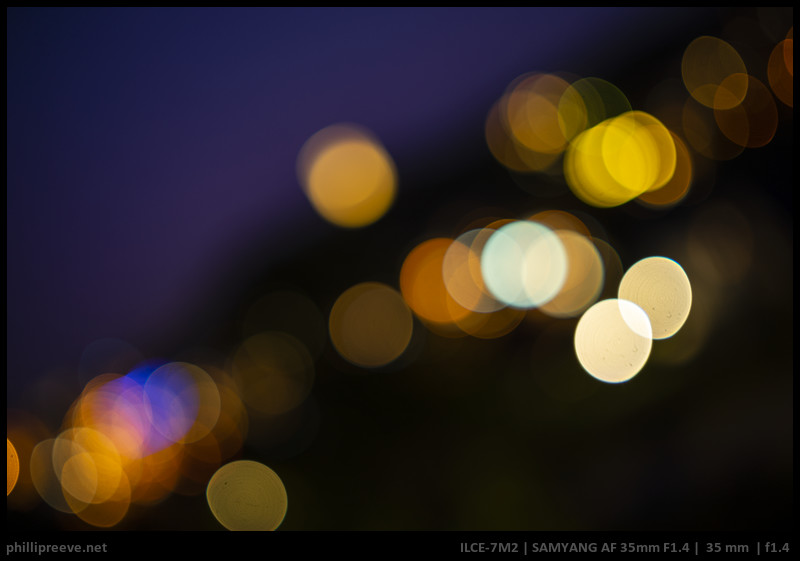
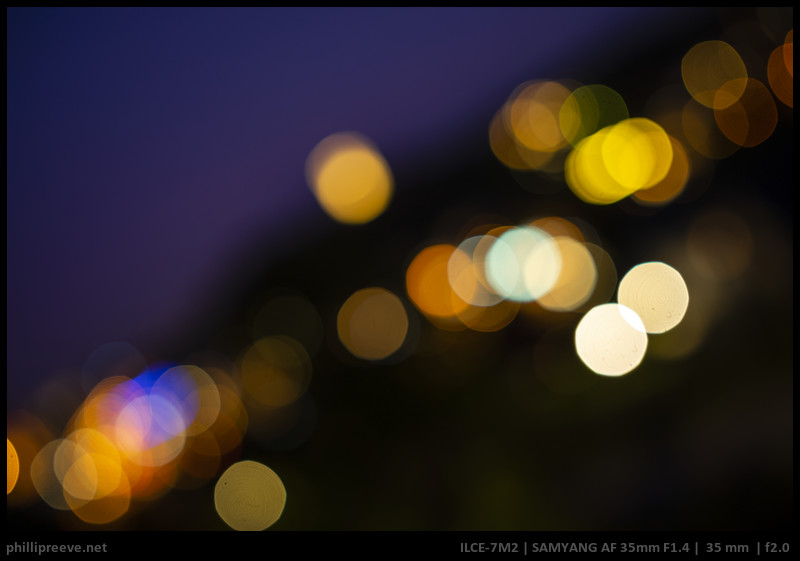
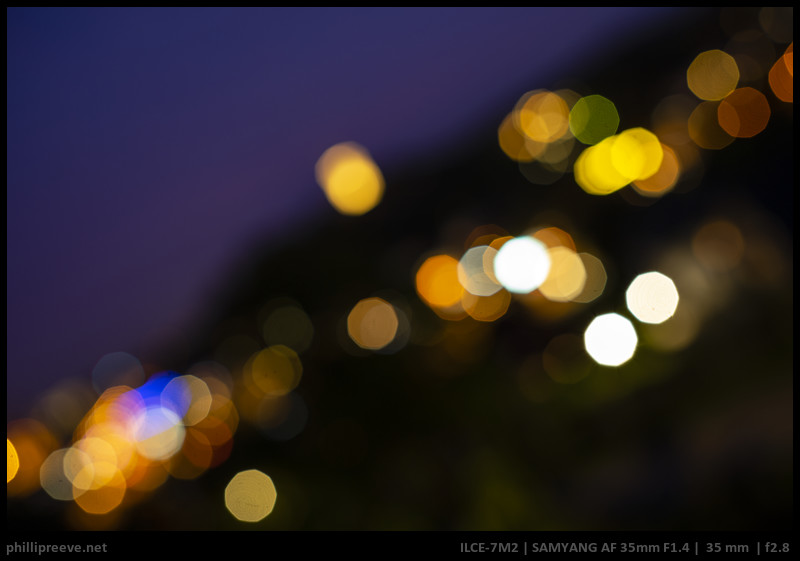
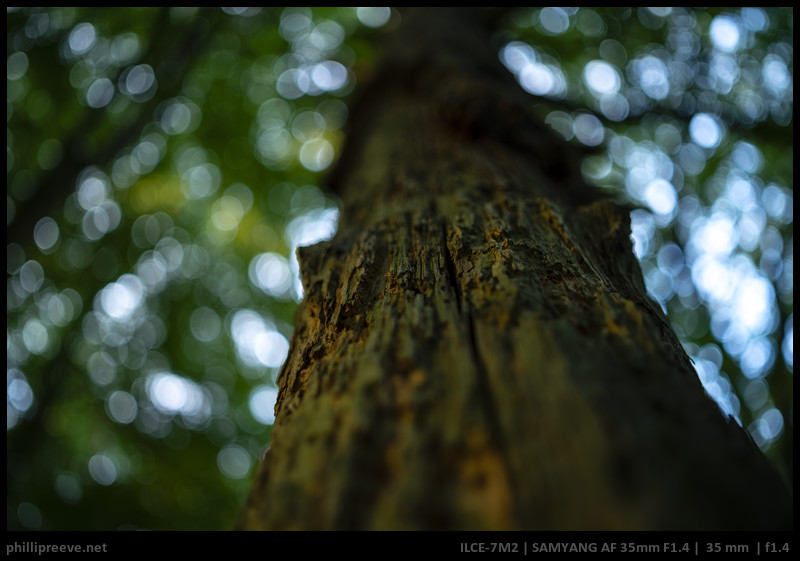
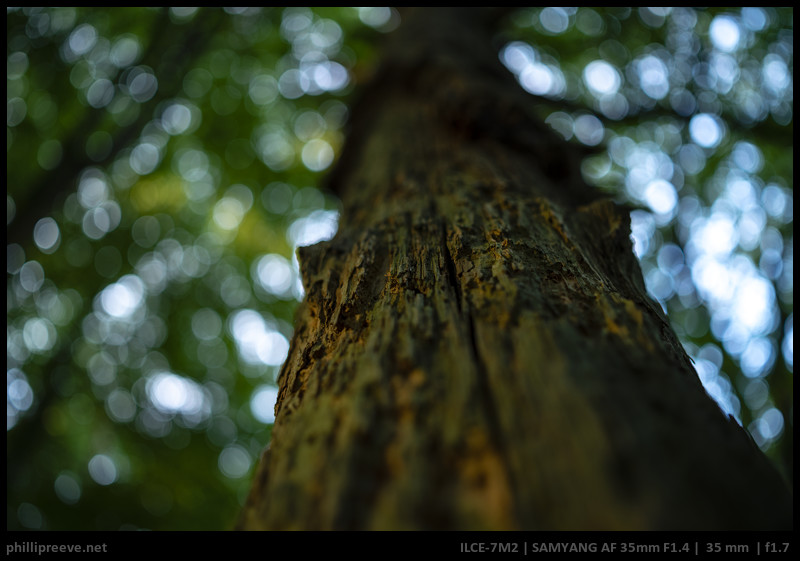
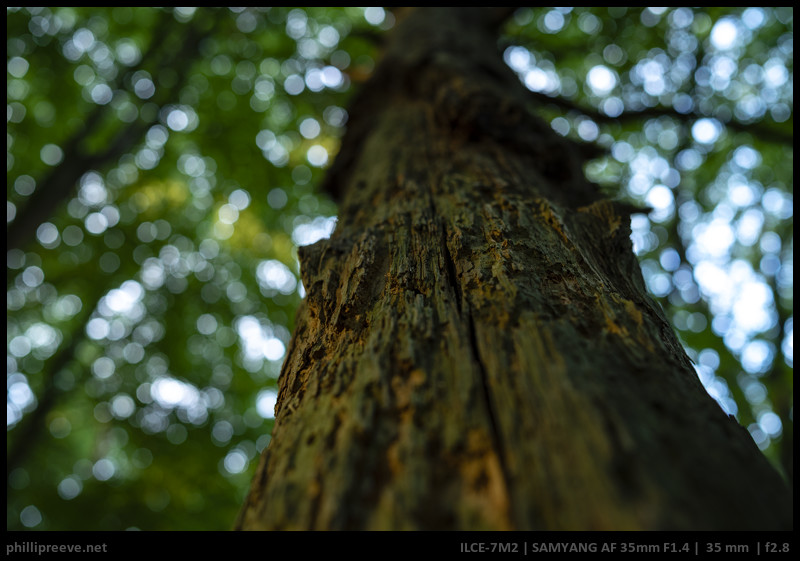

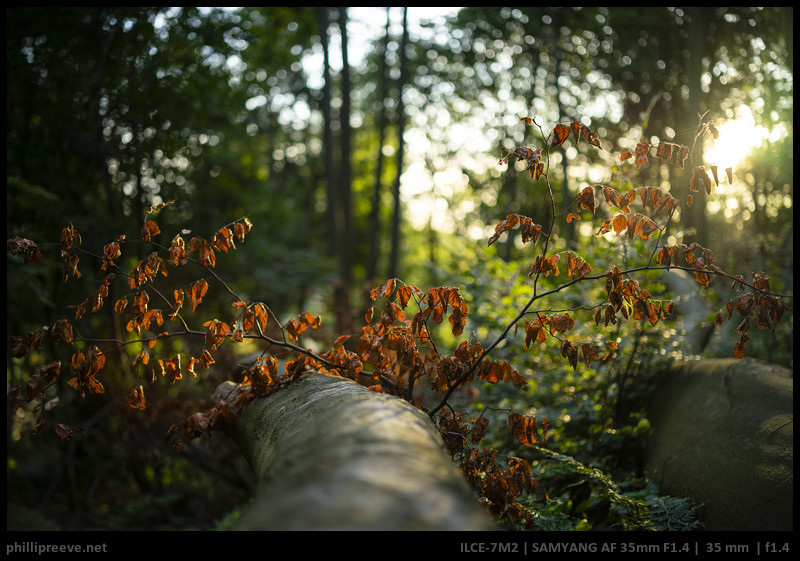
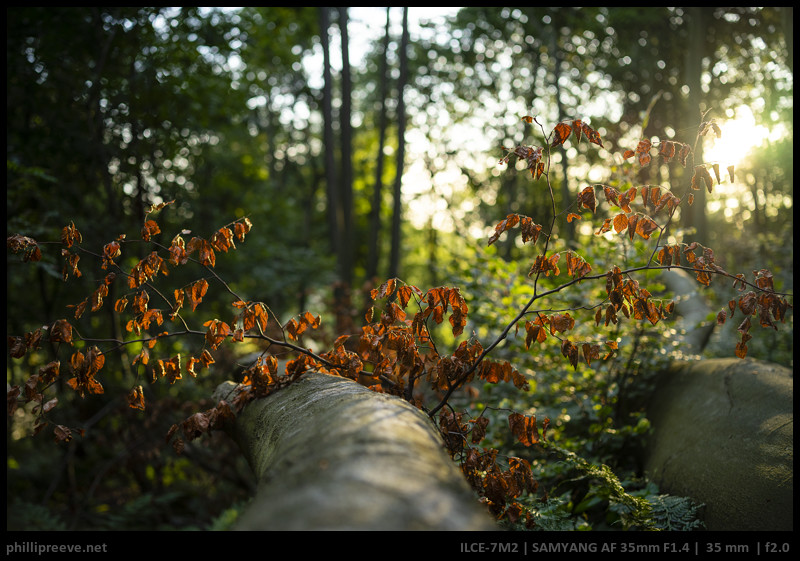

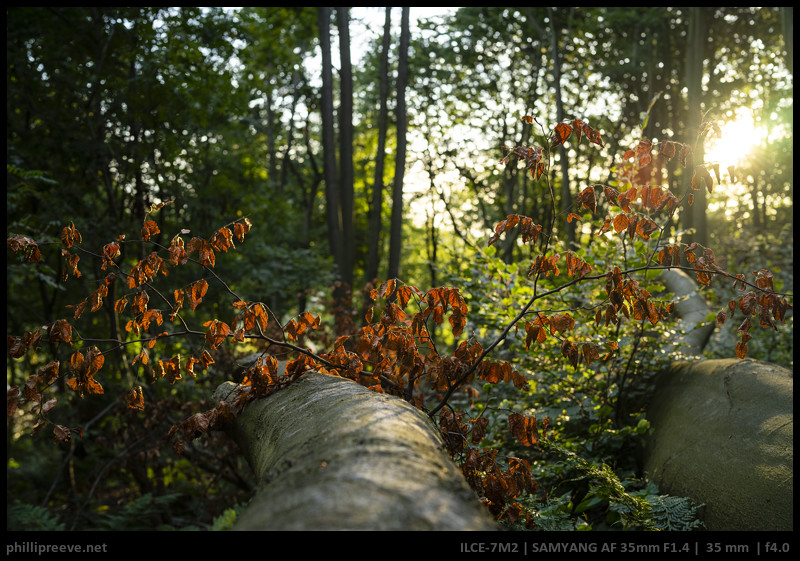
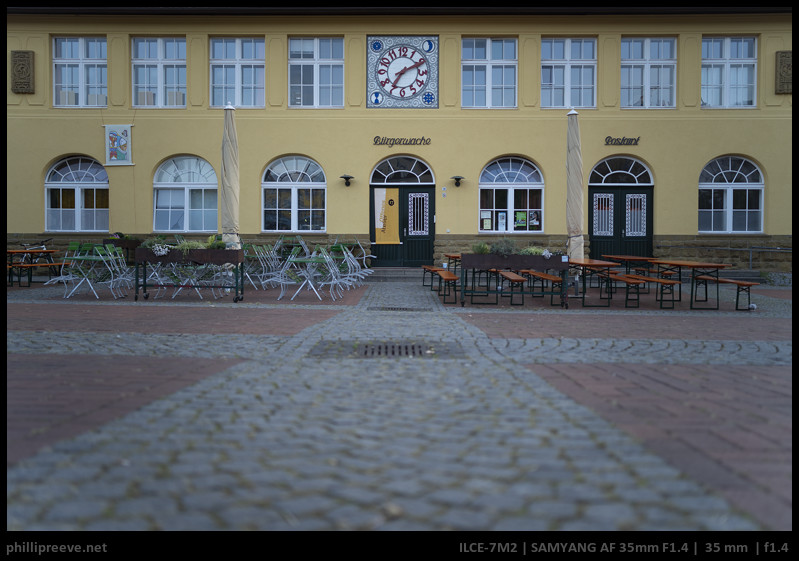
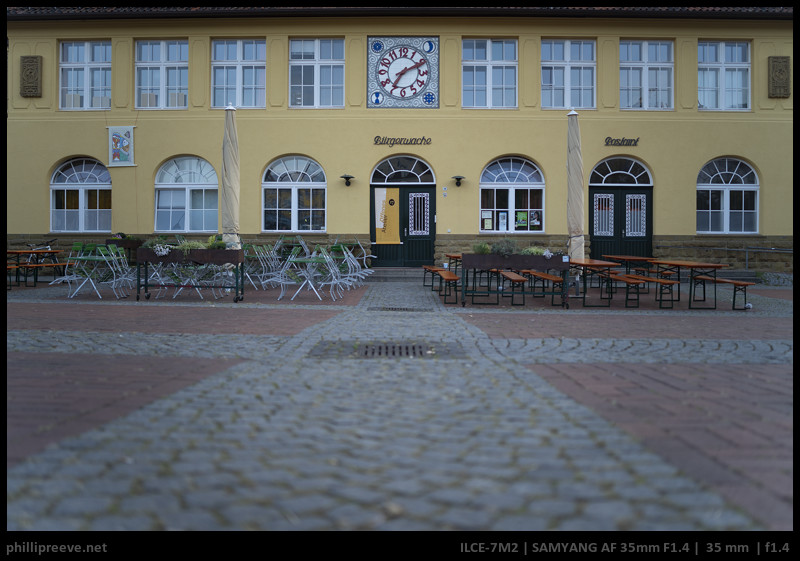
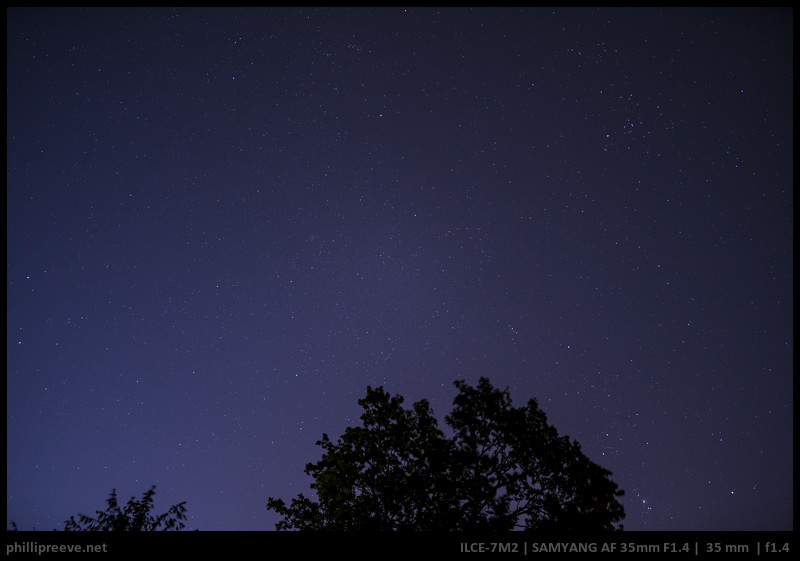
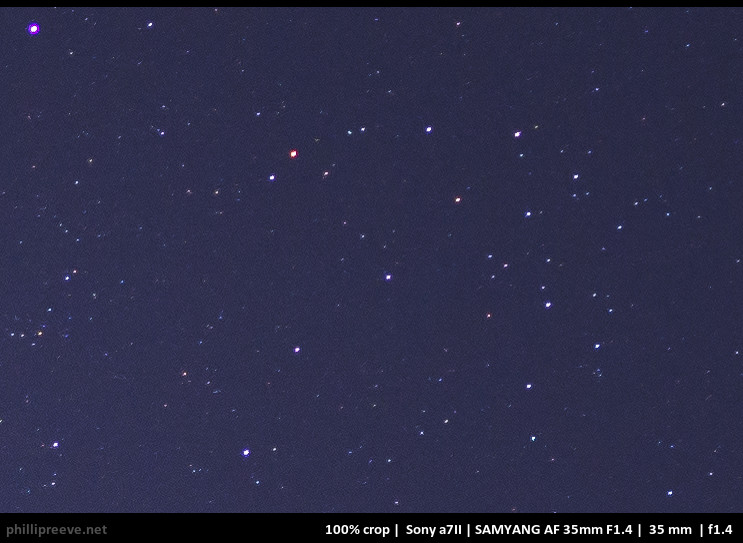
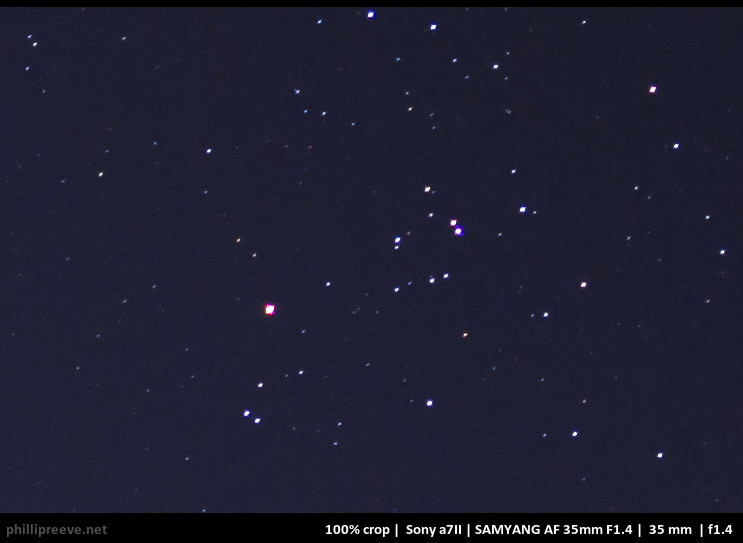
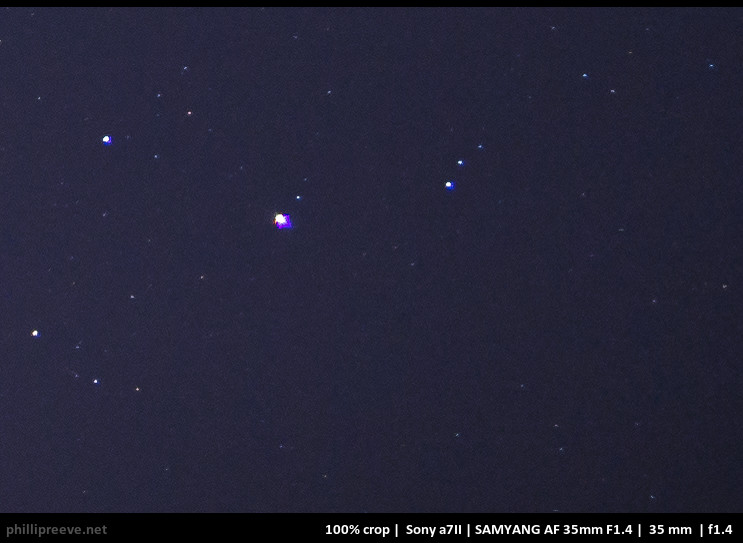
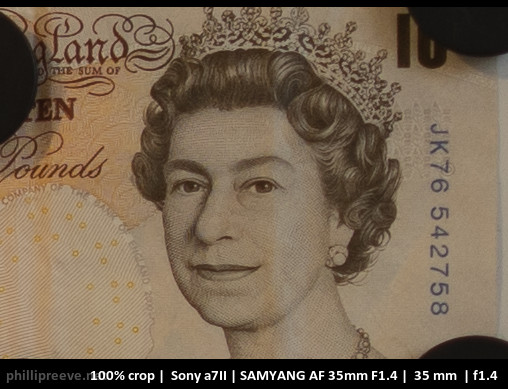
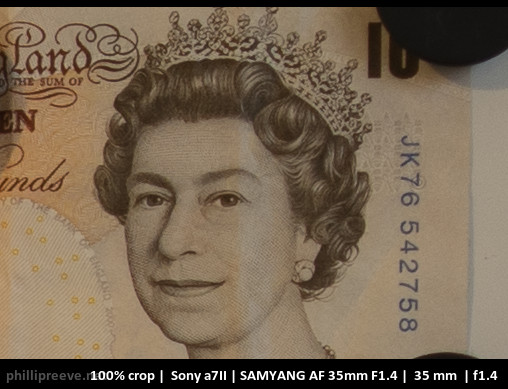
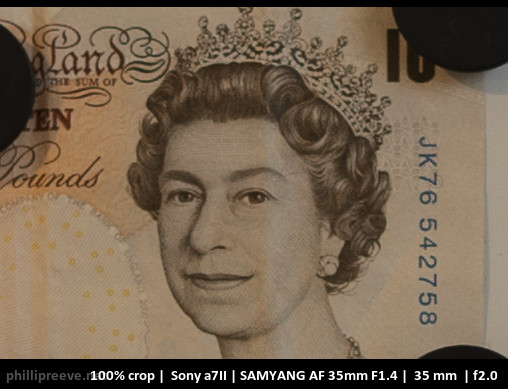
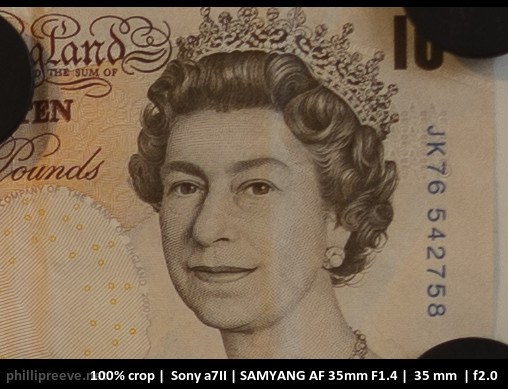
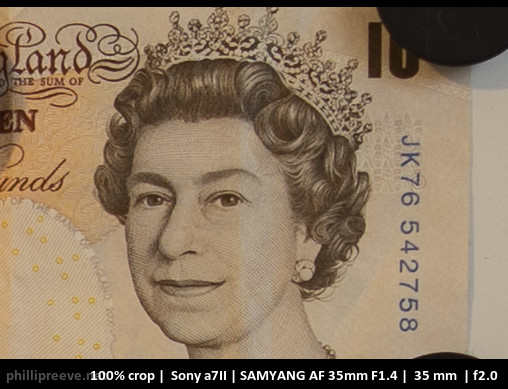
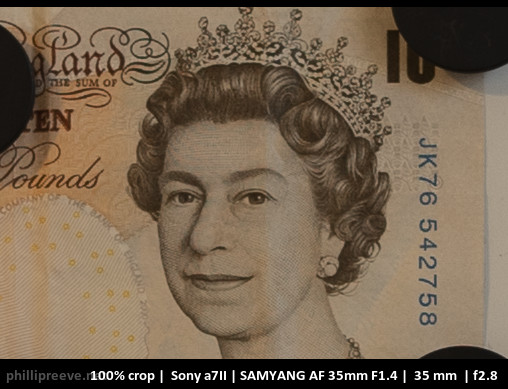
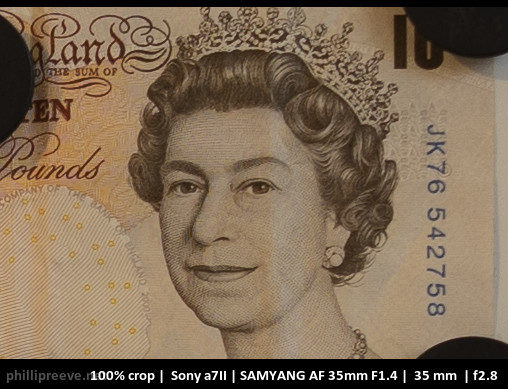
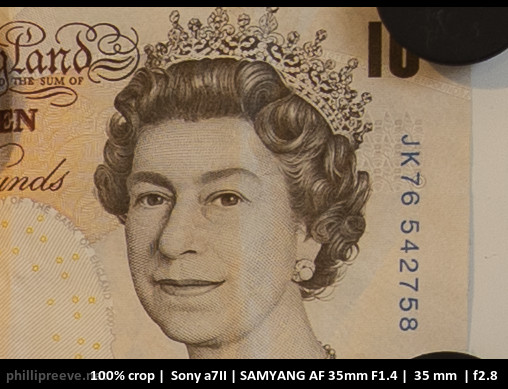
You did it again! Thank you
Only remark…, I do not see that the price of the FE 35mm f1.8 is much higher…, in your list it is less high, and on the internet you can find it less expensive…,but that’s the case for the Samyang as well.
right now at B&H it is $499 for the Samyang vs $699 for the Sony
I see the Sony for 600 here and there…, but you are right!
I can sell my Tamron 28-75 for almost 85-90% price of I bought, but the resell value of Samyang lenses is significantly lower. I think this represents the general perception of Samyang lenses; used Samyang lenses have bad centering quality or some other problem.
I wonder how good the centering quality of Samyang 85mm F1.4 FE would be, but as far as now, I’m not interested even if I can buy a bit cheaper than the rest of the world(about $550 after promo in South Korea).
I hope Samyang would make some challenging lenses next spring, like AF version of their famous 135mm F2 or niche lenses like 28mm F1.4, 105mm F1.4-1.8.
We try again and again to give Samyang a chance but the only reall positive review so far was the 2/135.
I would like to see a review of the 18 2.8, seems like a very neat little lens
Everyone who know of Samyang wants AF version of 135mm F2. I have asked that on their social media, but those questions never get answered.
Samyang get their Korean nickname 삼자이스, ‘Sam-Zeiss’ because of the lens. So I think they are discreet about their valued lens.
I like the astro performance of this lens very much. A tiny bit of spherical aberration which makes brighter stars larger in the image, and the aberration is very uniform in the image field without severe coma in the corner.
And yes it is a bit shame that the very nice optical performance is hindered by other things, including AF/MF and the difficulty for firmware update.
I agree, Haitong.
I owned fe 35/1.4 ZA before this lens release and very disappointed with the onion ring in bokeh… but everything else is satisfied.
some incentive to switching to this lens…(cry)
Hi Phillip, thanks for the review!
from what i’ve seen i actually like the bokeh of this lens alot more than that of the Sony FE 1.8/35.
Apparently you’ve shot them side by side, what would you say, how much better is the bokeh at full body/environmental portrait distance?
From these two shots the Sony looks much worse imo…
https://phillipreeve.net/blog/wp-content/uploads/2020/01/Samyang_35mm_f14_AF_FE_Review-09344.jpg
https://phillipreeve.net/blog/wp-content/uploads/2019/09/Sony_Fe_35mm_F18-2-9.jpg
I would say bokeh of the Samyang is noticeably better but I wouldn’t say that they are very far away from each other
Hey S.B.!
If I may contribute sth: from my personal experience, the Samyang works great for environmental portraits as in weddings, climbing/bouldering shots, workspace portraits, etc. It‘s not as sharp as for instance the Sigma 35 1.4, which might be a good thing to some.
To be more precise about the comparison between the Samyang and the Sony (which I could only test once in a store now): from everything I‘ve seen, it seems like the amount of perceived blur is more or less the same when the Samyang is at sth. between 1.8-2.0 and the Sony wide open, which is a bit weird, since the Samyang seems to be noticeably wider in FOV.
Furthermore, the Sony Zeiss 35 1.4 and the Sigma 35 1.4 have noticeably more blur than the Samyang when comparing same aperture, so it gets more complicated.
And then there are lenses like the RX1 Sonnar, which, despite being famous for being wider than 35mm has at least as smooth OOF rendering at 2.0 as the Sony 35 1.8 does at 1.8.
Also, the Sony introduces quite abrupt vignetting/not-so-smooth light falloff (seemingly much more than the RX1 or the Samyang), which (together with the price tag) holds me back from buying it most right now.
I thought about switching to Fuji (because of size, weight, handling) and their 23mm 1.4, which was tighter in FOV than the Samyang (compared on a tripod) and produced the look of 2.0-2.2, or the Sigma stopped down even further. For environmental portraits, that‘s unfortunately not enough for my taste.
If one can live with the vignetting & rendering, it seems like the Sony 35mm 1.8 might actually be the 35mm 2.0 many have asked for.
If size/weight is not an issue, I‘d recommend getting one of the other & faster 35mm lenses for full body portraits.
Thanks for sharing Aljosha, interesting insights!
I should probably try the Sony 1.8/35 for myself, it seems like a great lens for its size, but i have a feeling that i might dislike the bokeh in too many cases.
Thanks for your detailed review Philip. I had similar issues with the af using the A7II but was able to resolve those using the Samyang Lens Station. After updating the firmware and setting the lens calibration to 0 (it was for some reason set to +4 by default) the af now works just fine and reliable.
Thanks for the review (which I eagerly anticipated) & your effort!
Just two things on top I‘d be super happy to hear about from your perspective:
– did you find this lens to be noticeably different in FOV compared to the other 35mm lenses? I own this lens and found it to be quite a bit wider than the Sigma 35, which in turn seems to be wider (from what I’ve heard/seen online) than the Sony FE 35 1.8. Since I’m interested buying the Sony, I‘d love to hear if you can confirm that?
– did you find this lens to be significantly warmer colour wise (as other reviews have pointed out) compared to the other 35mm lenses?
Like I said before, a big THANK YOU for your effort to test & review all of these lenses 🙂
from what i’ve seen the sony offers a noticeably tighter FOV than most other 35mm. Dont quote me on that, but its probably rather 36mm (or the others are 34mm)…
Check out the 1.4/35ZA vs the FE 1.8/35 for example on this review https://www.dpreview.com/reviews/sony-fe-35mm-f1-8-review/3
https://www.dpreview.com/reviews/image-comparison/download-image?s3Key=71fac3237d284c5084abf68e1338c405.acr.jpg
https://www.dpreview.com/reviews/image-comparison/download-image?s3Key=ba1f0d8c5e8a4bb89b45927a032d2603.acr.jpg
I only shot is besides the Sony FE 1.8/35 and the Samyang is noticeably wider: https://www.flickr.com/photos/96189377@N08/49375272696/in/album-72157712639820381/ https://www.flickr.com/photos/96189377@N08/48775266857/in/album-72157711014856953/
I didn’t test color temperature, will try to do it later.
Thanks for the review. 🙂
I used this lens for several weddings / portrait session and the AF performance was never a problem for me on an A7mk3. On my older A7mk1, it is definately slow and sometimes unreliable, but that may be the bodies fault.
Thanks for sharing your experience!
Hi Stephan. How about the perfomance of third party lens, as samyang AF on a A7 mk1? I’m waiting for a new A7 to buy a body. Btw I shoot astro and use it for family reunions.
Owned this one and sold it. I was never happy with the AF performance, it was so hit and miss even on latest FW and the manual focus ring was the worst I’ve ever used. So those two combined pretty much made the lens unusable for me in critical situations. Shame as the optics were very solid for the asking price.
Hello Phillip,thanks for review.
I have found AF inconsistency with steady shot activated. Deactivating it would seem more reliable.
Best Regards
Vitantonio
Since I use my AF lenses in different situations, I have additional input that some people might find useful.
I find that on a Sony A7III, the eyeAF works well in less than ideal lighting (eg at a small venue rock concert).
From my experience, this is a lens that needs a lot of electricity to work well. The AF seems to work better when the camera battery is full, but it tends to become unreliable when you get below 50% charge, and gets worse from there. By comparison, I have no such AF/power problem with my two other go-to lenses for small rock concerts, the Sony 55mm 1.8 and the Batis 18mm.
That surely is a very interesting observation.
Another fantastic, in-depth review.
Any chance we’ll see one on the Samyang E-mount 85/1.4?
We have considered it and one day we might review it but not that soon.